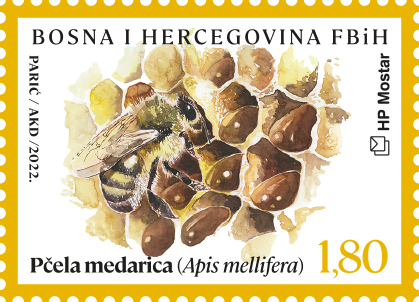Uvjeti korištenja

The body of the honey bee (Apis mellifera) consists of the head, the thorax, which carries three pairs of legs and two pairs of thin wings, and the abdomen. She flies from flower to flower, collecting plant nectar and pollen, which she brings to the hive. She bites with the front of the mouthpart, while the back part is the feeler that the bee uses to suck up liquid. There are five eyes above the mouthpart, which can detect some colors (blue, yellow and ultraviolet). She stores the nectar in baskets i.e. in depressions with hairs on her legs. The glands that secrete the honeycomb building material are located on the abdomen, which consists of nine rings. The abdomen ends in a jagged stinger, the bees' only defense.
The bee colony consists of three types of bees: queen, worker and drone. The queen is the only sexually mature female in the bee colony. Her task is to lay eggs, to take care of the colony and to keep the bees in the hive with the pheromones they excrete. The queen leaves the hive only once during mating. She is fertilized by the fastest drone, which reaches sexual maturity and then dies. Females (workers or queens) develop from fertilized eggs, while males (drones) develop from unfertilized eggs. The worker bee is a female with atrophied ovaries. In the absence of the queen in the community, she can lay eggs (unfertilized), but only drones hatch from these.